Table of Contents Show
With the surge in popularity of RVing from the COVID-19 pandemic, many traditional RV parks and campgrounds are full for the next year. So how can you get out and camp if you’re already too late to book a spot? If you play your cards right, you can go boondocking instead. But what if your RV is “too big” for boondocking? Listen up, because we’ve got some boondocking tips for a big RV!
What is RV Boondocking?
“Boondocking” is an RV slang term for camping without amenities out in the wild—or literally in the boondocks.
First, we should clear up a common misconception: “Boondocking” and “dry camping” are not the same. While it’s true that all boondocking is dry camping, not all dry camping is boondocking.
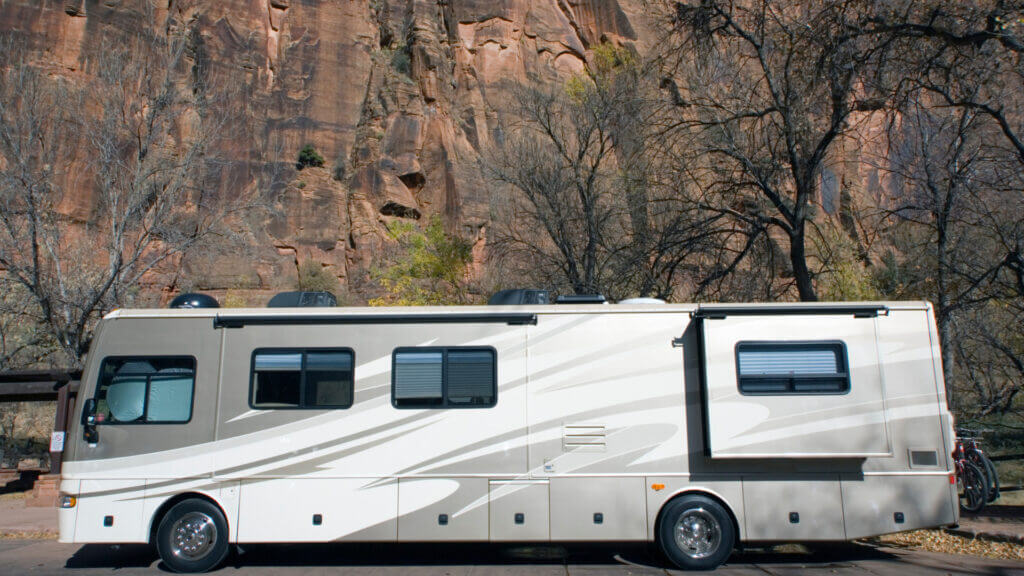
Confused? Let’s clarify.
Picture an RV park or campground that has full-hookup spaces and primitive spaces. If you camp in a full-hookup site, then you have a pedestal with an electric power connection, a faucet for city water, and a sewer cleanout for dumping your gray and black water. Everything is provided. But if you camped in one of the primitive spaces, you wouldn’t have any of those amenities. In other words, you are dry camping.
Dry camping could refer to a primitive space like our example. Or also, it could be crashing overnight at a Walmart, or Cracker Barrel parking lot. Even Cousin Eddie parking his land yacht in front of the Griswald’s home for the holidays!
Now imagine yourself dry camping in the wilderness. Now that is the heavenly world of boondocking. Boondocking affords you freedom in every sense of the word. You are free from an RV park’s boundaries, and you are camping for free because you don’t need to pay to stay. Plus if your RV is a large one, you’ll truly appreciate the freedom to camp without worrying about finding a pull-through space because the world is your pull-through space.
Where can you Boondock?
This is one of the two core issues you need to address before dropping anchor in the middle of nowhere. Are you legally permitted to camp here or not? And is your coach self-contained enough to dry camp without hookups? More on that in a moment.
Regulations vary from state to state, and as a general rule, the western states have more open lands where boondocking is permitted. It can be tricky to figure this out because there aren’t camp hosts to guide you when you’re out in the boondocks. And sometimes, land that appears to be wide open for the taking is off-limits. This could be because of grazing rights, mining rights, or even military use. Definitely get your hands on a BLM map (Bureau of Land Management). On here you’ll see miles of check boards plots alternating between open public lands and leased ranges.
These maps also clearly demonstrate any nearby military boundaries. So no accidentally trying to set up camp in Area 51!
Benefits of Boondocking in a Big RV
If you own a large RV, you’ll appreciate the wild open spaces even that much more. Finding the right spot to camp is as simple as finding a spot level enough to camp and terrain that isn’t too extreme for your rig. Some drivers are more adventuresome than others. And some large RVs lend themselves to boondocking more than others. For example, a sizeable fifth-wheel trailer does better on off-camber roads than a large diesel pusher. This is because the fifth-wheel doesn’t need to worry about twisting too much and possibly cracking an expensive windshield.
There’s nothing like camping in a spot far from others, where the only sounds are those from nature! If you trust your dogs, you can let them roam off-leash and rediscover their instincts. Your kids or grandkids can play and explore without disturbing anyone else. With proper care, you can enjoy a fire and the boundless night sky.
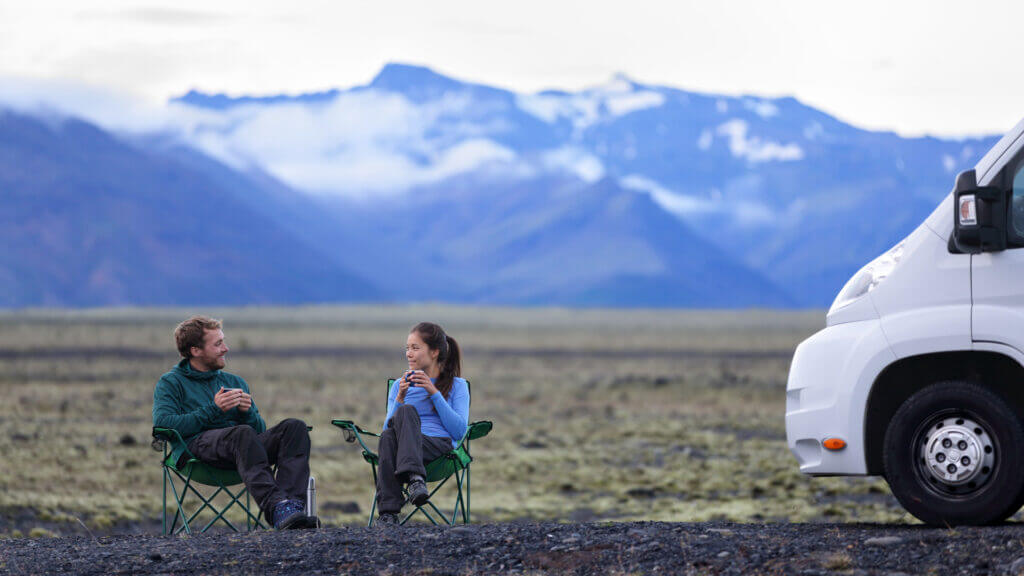
5 Boondocking Tips for a Big RV
Do a Dry-Camp Test Run
So what about your RV? Does your coach have the necessary capacities, and do you have the know-how to dry camp? Take a good look at your setup and figure these things out before you hit the road. Evaluate your rig and determine your weaknesses to figure out how many nights you can make it without hookups.
Power: How many batteries do you have, and what’s your plan to recharge them? If you only have one battery and no generator, you might not even make it through a night without running out of juice. Even with a more extensive power bank of four batteries, a larger coach with all its lights and appliances might still only make it a night or two. You’ll be better off with some way to recharge during the day. If you don’t have an onboard generator, think about purchasing a quiet portable unit or installing solar.
Prepare for disaster, though, and bring jumper cables and a powered jump pack in case you need it. Pack a tire plug kit while you’re at it.
Water: How big are your freshwater tanks, and how much do you use per person per day? If your coach is built for dry camping like many toy haulers are, for example, then you probably have over 100 gallons of freshwater, which can last for a week or more. It takes some practice and conservation, though. Consider showering less often and take shorter “marine” showers. If you have smaller tanks (or just one single tank), bring freshwater containers from the store and use them for drinking.
Waste Water: The most significant wastewater source isn’t showering or brushing your teeth; it’s washing dishes. Plan to either use paper plates or else take care to scrape and wipe your plates thoroughly before washing them and then keeping the faucet turned down as low as possible. This will help you extend both your freshwater as well as your gray waste tank. Your black tank won’t fill up as quickly, but if your tanks are small or your stay is extended, consider encouraging the men in your family to urinate outdoors.
Based on your capacities, multiply the number of people in your family by the number of days you hope to camp, and then divide that into the number of gallons in your tanks. If your family is large and your tanks are small, you might find that you only have a few gallons of storage per person per day, which won’t be workable without bringing an extra moveable tote to drain into.
Test Run: Once you’ve analyzed your setup and think you’re ready, camp for a night or two in your driveway without any hookups. Not only will this quickly teach you whether or not your batteries and tanks will last, but you’ll also identify all the things you forgot to pack for the trip. This driveway adventure is an incredible opportunity to adjust yourself to dry camping.
Get the Campendium App
The Campendium app and website are invaluable resources for boondockers. Campendium is a peer-driven review service for overnighting. Unlike other RV park review apps, Campendium also includes dry camping locations and actual boondocking sites. The info is so complete, it almost feels like cheating. One great boondocking tip for a big RV is using the “Longest Rig Reported” option, which shows you how large an RV can fit into the spots.
Get a Lay of Land via Satellite
The other service that feels like cheating is satellite imagery from Google Maps and Google Earth. Once you have a general idea of where you want to camp, turn on Satellite View in Google Maps and pan around the map to narrow your search. For even better results, use Google Earth to view the area in 3D and get a better feel for the topography.
The four things to look for in Google satellite images are:
- Clearings: It’s sometimes hard to tell if a site is level or suitable since the images are two-dimensional, but seeing a clearing is your first good clue that people have camped there before. The main characteristic to look for in a clearing is the color contrast. Most of the time, clearings are pale compared to the surrounding brush or trees. If you don’t see pale clearings, then look at the soil color of the dirt roads because the clearings should match. For example, in areas with red sands, the streets will be red, and so will the clearings.
- Fire Rings: Once you’ve found some potential clearings, zoom in and try to recognize any fire rings. A ring of stones in a clearing is a sure sign that people have camped there before you. Use the scale of the fire ring to estimate the size of the clearing to get a better idea of whether your rig will fit or not. You don’t want to pull up to a site just to discover that it’s for backpackers and not your Class A.
- Access: This is a two-parter. Pan around the map to get an idea of how good the access roads are and how far the site is off the highway. (Only you know how close or far you want to be from the paved roads.) If the roads aren’t good, though, it doesn’t matter how nice the site might be. Watch for any splits or detours in the dirt roads because these are clues of obstacles: unpassable sand, rocks, trees, or old muddy puddles. Any one of those could prevent your access or even get you stuck. The second thing to look for is actual access to the site. Is the area surrounded by trees, rocks, or brush that will prevent you from getting in? And once you’re in, is the place large enough to turn around to get out, or is there a second access path you can use for egress?
- Plans B & C: By the time you’ve played satellite sleuth long enough to find the site of your dreams, you might have tunnel vision that rules out any alternatives. If your primary place is that perfect, though, there’s a chance that somebody might have beat you to it. Make sure to keep your eye out for alternative spots in case your first choice is already taken.

Stay in a Campground the Night Before
Once you’re ready to go, make sure all of your resources are appropriately full or empty. Your batteries and freshwater should be full, and your gray and black tanks should be empty. If you can’t make all this happen at home, then stay your first night in a camp with full hookups so you can dump your tanks, fill up with water, and charge your batteries.
Scout Ahead
No matter how good your aerial reconnaissance was, there’s a possibility that you goofed or that something won’t be what you anticipated. Listen to your inner Clint Eastwood and be prepared to improvise, adapt, and overcome.
If the road to camp is wide, flat, solid, and dry, then cautiously proceed. If things seem dicey, think about scouting ahead in your toad, tow vehicle, or even on an e-bike to inspect the site and the access visually.
And whatever you do, never arrive in the dark. Even if it’s a spot you’re already familiar with, don’t press your luck. It just isn’t worth it.
Exercise Proper Etiquette
Boondocking etiquette can be summed up in two pithy aphorisms:
- Follow the Golden Rule and treat others as you would want them to treat you.
- Pack it in, pack it out.
“Pack it in, pack it out” is simple. You’re in the boondocks where there aren’t any camp hosts or dumpsters. It’s up to you to make sure that every scrap of foreign material is bagged and removed from camp. And that doesn’t just mean the stuff you brought in. If you see an old junked tire or a bunch of shotgun shells, pick them up and bring them with you to throw away at home. Since there’s no housekeeping in the boondocks, the good and caring citizens are the ones who maintain the sites and keep them nice for the future.
Watch out for hidden litter too. For example, watch what you burn in the fire rings. Don’t burn pallets or scrap lumber with nails, screws, or other hardware. Not only does that stuff not burn in your fire, but it will become a puncture hazard in the future. Those fire rings that seem like they’ll be there forever won’t. And when someone picks up all the rocks to make a ring someplace else (by the way, please don’t do that), all your unburned nails and deck screws will magically transform into tire-poppers. (That’s why you should always have a plug kit and a compressor.)
For the Golden Rule, always think about what impact your actions could have on others. Most of us like to listen to our favorite music outdoors, but you should first look around and figure out where your closest neighbors are. If they’re close enough to hear your noise, then you should keep it quiet.
One of the best parts about boondocking is letting the kids, grandkids, and dogs run feral. It’s good for them to get dirty and chase kangaroo rats (the dogs, not the kids). Use your judgment though, and make sure your kids and dogs stay safe.
Many people like to dump their freshwater before they hit the road so they can get rid of some weight. That’s fair, and it’s legal, but the next group shouldn’t have to camp in a mud hole either. If you’re going to drain your freshwater, wait until you’ve entirely pulled out of your camp before you open your valve. It’s common to see thin wet trails along the roads and trails from people draining their freshwater. There’s no harm to it, as long as it doesn’t make a mess out of a campsite. But never drain your gray or black water in the boondocks. You wouldn’t do that in an RV park, and it’s forbidden in the wild.
These are just a few points of etiquette. Please use your common judgment and be a good steward to the lands and a good citizen to your fellow campers.

Conclusion
There’s nothing like boondocking, where the price is free, and the camping is free-er. Once you get the hang of it, you’ll likely find yourself boondocking more often than staying in RV parks. There’s a little more risk, but that’s part of the adventure. If the open road and the open land calls to you, then answer the call and head for the boondocks. Hopefully, these boondocking tips for your big RV will help you enjoy this vast country of ours.




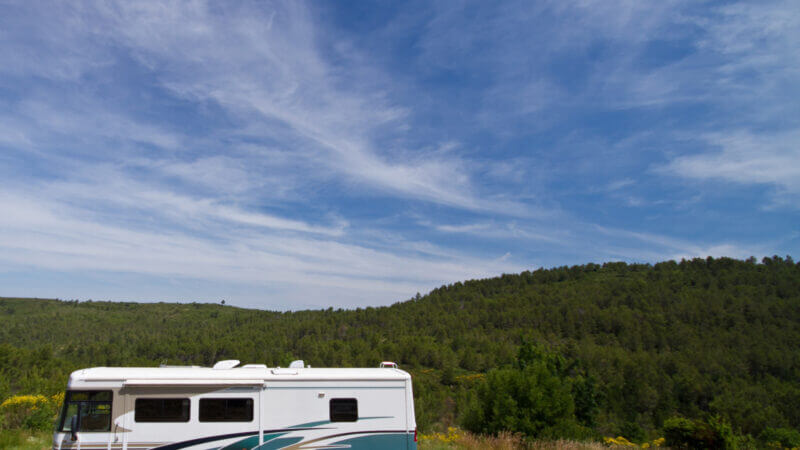
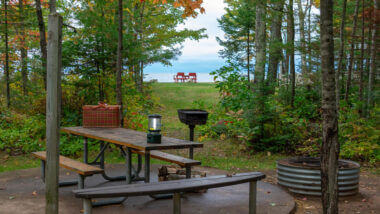
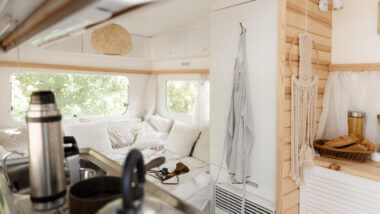
Thank you for the well written article ❤️